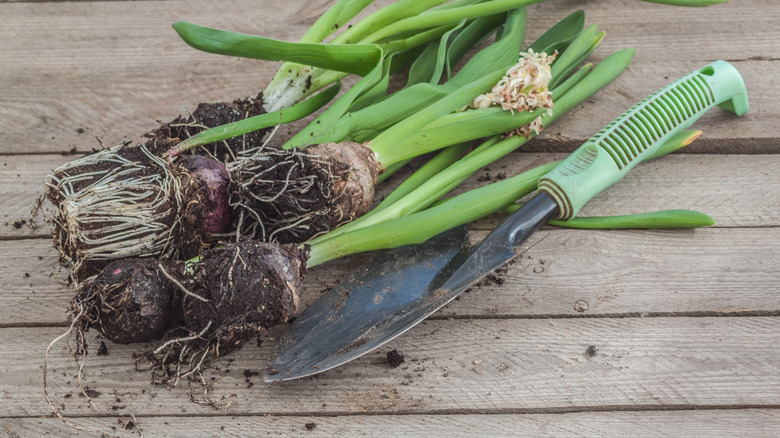How To Avoid Hyacinth Bulbs From Being Destroyed By Mold
Hyacinth is a showy and fragrant flowering bulb. These plants are renowned for their blue blooms, the rarest of all flower colors, but they also boast purple, pink, red, or white flowers. No matter what petal hue you choose, hyacinths are always grown from bulbs. One of the best things about nurturing a few hyacinths is that you can force them to sprout and bloom indoors and out of season. However, the problem with forcing hyacinth bulbs is that they need to be kept moist, something that also makes them highly susceptible to mold. How do you prevent these bulbs from being destroyed by mold before you have a chance to enjoy their beautiful blooms? You need to choose healthy bulbs grown in ideal conditions and store them appropriately.
It's vital to keep moisture levels low while hyacinth bulbs are in storage. Moisture itself doesn't cause or create mold — mold grows from fungal spores. Moist and wet conditions only trigger and encourage their growth. If you use store-bought bulbs, inspect them carefully and choose only the healthiest to plant. If you harvest your own bulbs for later use, make sure you're not contributing to soil conditions that harbor mold spores or help them develop. If you're planning to keep the bulbs for a while before forcing them for indoor display, you need to avoid storage mistakes that are hurting your bulb's chance of success.
Choose healthy bulbs, then keep them clean and store them right
Often, hyacinth bulbs are susceptible to mold well before you even think about storing, forcing, or planting them. If you plan to harvest bulbs from your garden for next season, disinfect all tools, trays, pots at all stages of the growing season, and even the bulbs themselves with a water and bleach solution at a 1:9 ratio. This should significantly reduce lingering mold spores. Make sure your plants are not growing in waterlogged soil, heavy clay, or fresh manure. These conditions are breeding grounds for rot (and therefore mold), which may contaminate the hyacinth bulbs you plan to harvest later.
Whether you have store-bought bulbs or your own-harvested bulbs, select only the healthiest among them for storage or forcing or planting. The least mold-prone bulbs will feel firm, solid, and heavy for their size. If the bulbs look shriveled or feel weightless, chances are they're already rotten or moldy. Check, too, for the telltale signs that your flower bulbs have gone bad: squishy spots, discoloration, or gray patches. If you spot a small patch of mold on a bulb, slice it off and apply a little fungicide. Not using your carefully selected, healthy hyacinth bulbs immediately? Make sure they're completely dry, then store them in a cool, dry, and well-ventilated place. This could even be your refrigerator. Remove store-bought bulbs from the moisture-trapping plastic bag they came in and put them in a hessian or paper bag for storage.
Forcing best practices to keep hyacinth bulbs mold-free
Forcing hyacinth bulbs indoors requires you to keep them cool, moist, and out of direct sunlight. These also happen to be the ideal conditions for mold growth, including gray mold, to which hyacinth bulbs are particularly susceptible. Therefore, you must exercise caution at every step when forcing hyacinths. Start by thoroughly cleaning and disinfecting your flower pots. Use soil fresh from the bag — or even better, use a soilless potting mix or small stones. Never use garden soil. Garden soil compacts easily and can create drainage issues. After planting your hyacinth bulbs in their pots, water them well. As soon as the soil feels like a wrung-out sponge, stop watering.
The bulbs will take a 10 to 12 weeks to form roots — called the cooling period. During this period, don't let excess moisture accumulate. It is the worst thing you can do to your hyacinth bulbs. Once you see roots, move the potted bulbs to a bright yet cool spot in your home. This will not only increase the bloom life but will encourage healthier growth, making them better able to handle infections, including mold. During the forcing process, check if the humidity levels in your home are good and don't leave any standing water in the plant pot saucer or nearby. Mold thrives in high humidity. Don't overcrowd the pots of bulbs. Mold spreads faster in close quarters.


